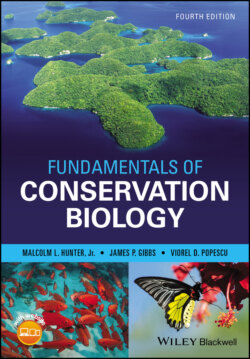Читать книгу Fundamentals of Conservation Biology - Malcolm L. Hunter Jr. - Страница 16
A Brief History of Conservation
ОглавлениеThe roots of conservation are lost in prehistory (Fig. 1.1). No doubt there was a time when human reason, growing ever more sophisticated through the millennia, began to extend the idea of deferred gratification (“save this fruit to eat tomorrow rather than now”) over much longer periods. Keep in mind that for 99% of our history as a species we were living in small, self‐regulating groups of humans entirely dependent on wild species. Thus conservation has long been intrinsic to our welfare as expressed in the form of edicts and practices such as “Leave these tubers so there will be more next year when we pass this place.” Or “Do not kill the pregnant females in this herd of peccaries so next year we will have even more to eat.” Or “Nobody shall hunt in that sacred area near our home grounds.” Certainly, such practices were simple, almost analogous to the food caching exhibited by many animals, but they were widespread and effective in governing human activity and represent conservation nevertheless. They remain relevant to this day, most notably in the practices of indigenous people who still live subsistence lifestyles in self‐regulating societies using wild species (Berkes and Turner 2006).
Figure 1.1 The roots of conservation can probably be found among the earliest Homo sapiens such as the people who painted this mural in the Lascaux cave in France.
(Thipjang/Shutterstock)
Leaping forward, history records many examples of conservation throughout the ages and across cultures. For example, the biblical story of Noah's ark remains a popular metaphor for conservation, and the Bible also codifies the first‐known game conservation law:
If you come on a bird's nest, in any tree or on the ground, with fledglings or eggs, with the mother sitting on the fledglings or on the eggs, you shall not take the mother with the young. Let the mother go, taking only the young for yourself, in order that it may go well with you and you may live long. (Deuteronomy 22:6–7)
(In other words: don't kill mother birds.)
A far broader law was promulgated by Asoka, emperor of India 274–232 BCE:
Twenty‐six years after my coronation I declared that the following animals were not to be killed: parrots, mynahs, … wild geese, … cranes, bats, queen ants, terrapins, … tortoises, and porcupines, squirrels, twelve‐antler deer, … rhinoceroses, … and quadrupeds which are not useful or edible…. Forests must not be burned.
Many laws focused on regulating rather than prohibiting the exploitation of species. For example, Middle Eastern pharaohs issued waterfowl hunting licenses, and night hunting was banned in the city‐states of ancient Greece (Alison 1981). Early regulations emphasized trees and birds, mammals, and fish caught for food, but all species and whole ecosystems benefitted from the popularity of declaring preserves. Starting at least 3000 years ago with Ikhnaton, king of Egypt, and continuing with the royalty of Assyria, China, India, and Europe, as well as with the Greeks, Romans, Mongols, Aztecs, and Incas, history has recorded many decrees setting aside land to protect its flora and fauna (Alison 1981).
Conservation was an issue during the period when European states were colonizing the rest of the world because colonization often led to disruption of traditional systems of natural resource use and rapid overexploitation. Freedom from European game laws was a significant stimulus to colonization, and hunting was a major preoccupation of the colonizing class. Imagine how attractive the promise of abundant, freely available game would seem to people who feared for their lives whenever their appetite for meat led them to poach one of the king's deer. This phenomenon was particularly true on some small, tropical islands such as Mauritius and Tobago, and continental Africa (Grove 1992 , 1995 ; Prendergast and Adams 2003).
Of course game species did not fare well under the onslaught of hungry colonists and soon regulations had to be enacted. For example, as early as 1639 it was illegal to kill deer between May 1 and November 1 in parts of Rhode Island (Trefethen 1964) and the Cape Colony in southern Africa had game laws by 1822 (MacKenzie 1988). This basic pattern – human populations growing, developing new technology for using natural resources, leaving crowded places and colonizing new lands, disrupting and displacing native peoples and their long‐standing practices in these colonized areas, and then responding to overexploitation and expanding population with an array of ever more restrictive regulations – has been repeated across the globe and continues to this day.
With increasing human impacts, the abuse of resources other than trees and large animals also began to be recognized, albeit slowly, for species that lack obvious economic value such as most invertebrates, small plants, amphibians, and reptiles. Aldo Leopold (1949) called for saving every species with his well‐known admonition, “To keep every cog and wheel is the first precaution of intelligent tinkering,” but it was not until the 1960s and 1970s that the idea of “endangered species” (so imperiled that they were about to disappear from the face of the Earth forever) became a major issue for conservationists. During this period many nations passed laws (e.g. the United States Endangered Species Act) to form an umbrella under which all animal and plant species threatened with extinction could, in theory, benefit from conservation intervention. In practice, however, plants and smaller animals still are not given equal treatment, and other components of biodiversity such as microorganisms, genes, and ecosystems are usually not explicitly under the umbrella at all.
This brings us to the point of departure for conservation biology and this book, but first let us briefly return to preservation, environmentalism, and ecology to see how they mesh with the larger history of conservation.
